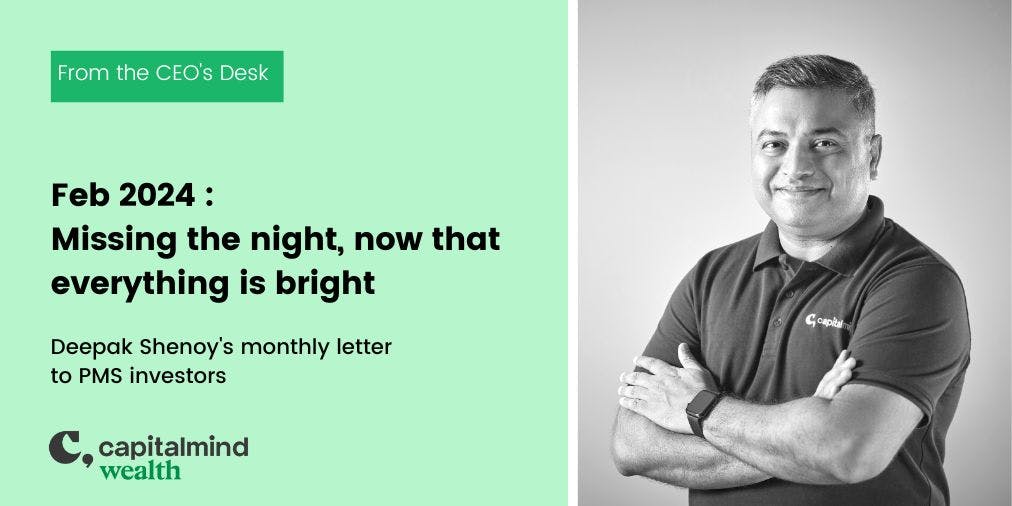(category)Deepak's Memos
Of Budgets and TariffsOf Budgets and Tariffs
Deepak Shenoy•


Recent performance has sucked, indeed. Long term performance is still good. We continue to believe in our process and strategies and believe strongly that the markets and economy will recover and allow us to participate in the trends that will change the country. You’ve got the Momentum note already from Anoop; this here is a little more on the events that have happened.
The Crazy Weekend
Two things have happened over the weekend that seem to be revolutionary. The first one is the Budget, which is usually a set of boring statements juxtaposed with poetry to an audience that primarily involves thumping wooden tables. This time was different.
After what seems like a relentless increase in taxation, the government has finally cut taxes for individuals, across the board. The budget’s just given us a bonus of around Rs. 110,000 a year each. That’s pretty much the highlight of the speech, which the finance minister left for the absolute end, because any earlier and the rest of the speech would have been ignored. Here’s a quick set of highlights:
- The tax slabs have been widened, and for incomes more than 24 lakh, you will save Rs. 110,000 more on your taxes. Most tax payers will save something so there is a little bit of relief. Importantly, incomes of Rs. 1 lakh per month have no tax at all - if that’s all the income you have.
- They’ve not increased subsidies. Food, fuel and fertilizer - the big items that have eaten up good portions of government budgets. Keeping them constant has allowed the government to focus on a few things we must be doing anyhow.
- Budgets will push inland shipping, nuclear technology, solar, electronic manufacturing, and a general move to help MSMEs and industry through cheaper credit (guarantees from the government).
- The deficit - what the government spends minus what it earns - is targeted to be absolutely steady, and in absolute terms, even lower than the current year. This helps in a different way; we’ll get to that.
We have a podcast on this (Click here) which talks about things in a simplified way,
Will the lower tax rates spur consumption? That’s the bet, really. Approximately 1 crore people will see lower taxes, and around 100,000 cr. more is likely to get to people’s pockets. That’s going to either be spent or invested. Whatever’s spent makes other people some money, so they get to spend more, and so on. This is the “trickle down” theory, often derided in western economies where it simply doesn’t work. And it probably won’t in the “very rich” class, for whom the extra 1 lakh a year doesn’t add meaningful benefits.
But it does help for a lot of people that make, say 50 lakh or less, where the tax cuts will result in a meaningful change in consumption. Henry Ford, in 1914, doubled employee wages to ensure retention. That allowed them to have a third shift, and highly motivated workers, and eventually the employees were able to afford Ford cars themselves. The extra money has only two major options - invest it, or spend it. If people spend on useless things like gold, that won’t help (and only increase imports, thus hurting GDP growth). If they buy real estate, stocks or mutual funds, that’s probably helpful. If they spend part or all of the excess, it will spur small businesses in the major cities (which is where taxpayers are).
The budget, to us however, is important because it curtails subsidies and increases focus on making more for India. From electric vehicles, to startups, to nuclear and solar energy, to inland shipping, to electronics manufacturing, there’s focus on making things for ourselves.
Finally, the best thing that can happen now is a rate cut. To meet the demand that might come, we will need corporate capex to be revived, and a deleveraging cycle that has lasted 10 years now must reverse. Rates will be cut by the RBI only on two thoughts - one is if the government has the fisc under control (which it seems to) and the second is if inflation is under control (inflation is coming down closer to 5% now) A rate cut will charge the economy a little more.
Interestingly, the government saved Rs. 25,000 cr. in the current financial year by having to pay less interest, as yields have fallen. If yields continue to fall, we might see the biggest ticket item in our budgeted expenditure (25% of the expenses = Interest Payments) come down meaningfully. And that means an even lower deficit.
So, in all, the budget’s a decent positive for the economy. But there’s the second thing that happened over the weekend…
US Tariffs on Mexico, Canada and China
The US has decided to impose 25% tariffs on Mexico and Canada, and 10% on China. This is going to hurt all these countries, including the US, to some extent. India shouldn’t rejoice - surely, India will also get tariffs soon.
Canada and Mexico have already responded by tariffing goods from America, but when more than 75% of their exports are to the US, they will have a much larger hit. America too has around 35% of it’s imports from these two countries, and unless they quickly find substitutes, prices in America will go up. Remember, tariffs are paid for by Americans, not by these countries.
India’s had tariffs for a long long time. We’re still growing, and when America and Britain were growing, they had 40% to 50% tariffs too. Cut to now, India’s used to having tariffs, as is China. We see a decent chance that the tariff game makes the whole world more insular - by tariffing all external trade, just as quid-pro-quo. This situation is good for India for now - because we will push our make-in-India even faster so that we are more self reliant in a structural way. That push will require deregulation of labour and land laws, but when this does happen, it will create more jobs, and thus more to spend on the things that are made in India again. In essence, India is likely to lose less in a world that requires each country to be self reliant, mostly through tariffs.
None of this happens overnight. So expect volatility. The sun shines brighter after a storm, because the storm washes away the smog that made it difficult to see. We’re going to get that storm, but if we weather out this one, we’ll come out into what should be more sunshine.
The “kehna kya chahte ho” (what are you really saying) version of this is: Things are going to get worse before they get better, but the better will be worth it.
If you ask me, this is one of the best times to invest. Precisely because, in all this uncertainty, it appears to be one of the worst times to invest. Markets look terrible and bleak just at the time when things start to turn around. And while we might be worried about the economy, the results season continues to show decent growth, with just about half the companies having declared results. Nifty 500 companies have grown earnings by around 10%, and Surge India companies, around 19%. The risk here is that tariffs can hurt some companies heavily, but in the long term they will benefit.
I do not often say this, but I will now : I would encourage you to consider adding to your portfolios spread out over the next few months. (I don’t say this because we are obviously biased, as we make fees on all such investments, so it might sound hollow)
We’ve had a townhall recently and we have spoken of a few of the moves in Surge, in Capitalmind and the overall markets. Do take a look if you missed it.
Lastly, just as things change, it can change for the better just as it can for the worse. Till a month ago, the US was unbeatable in AI, until DeepSeek came along. Two months ago, India was the brightest star in the sky, and in January, as nearly 80,000 cr. exited the Indian markets, we became a “has-been”. Narratives, sometimes, follow stock prices. It’s our job to identify what will shine when the narratives change again, and we hope to continue to do that for you.
Tax-rebatingly,
Deepak
Related Posts
Make your money work as hard as you do.
Talk to a Capitalmind Client AdvisorInvesting is not one size fits all
Learn more about our distinct investment strategies and how they fit into your portfolio.
Learn more about our portfoliosUnlock your wealth potential
Start your journey today



